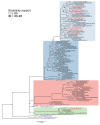Highly Pathogenic Avian Influenza A(H5N1) Virus Outbreak in New England Seals, United States
- PMID: 36958010
- PMCID: PMC10045683
- DOI: 10.3201/eid2904.221538
Highly Pathogenic Avian Influenza A(H5N1) Virus Outbreak in New England Seals, United States
Abstract
We report the spillover of highly pathogenic avian influenza A(H5N1) into marine mammals in the northeastern United States, coincident with H5N1 in sympatric wild birds. Our data indicate monitoring both wild coastal birds and marine mammals will be critical to determine pandemic potential of influenza A viruses.
Keywords: Caniformia; H5N1; New England; United States; avian influenza; ecology; gray seals; harbor seals; influenza; virology; viruses; zoonoses.
Figures


References
-
- World Organisation for Animal Health. World animal health information system [cited 2022 Jul 19]. https://wahis.woah.org/#/dashboards/qd-dashboard
Publication types
MeSH terms
Grants and funding
LinkOut - more resources
Full Text Sources
Medical

